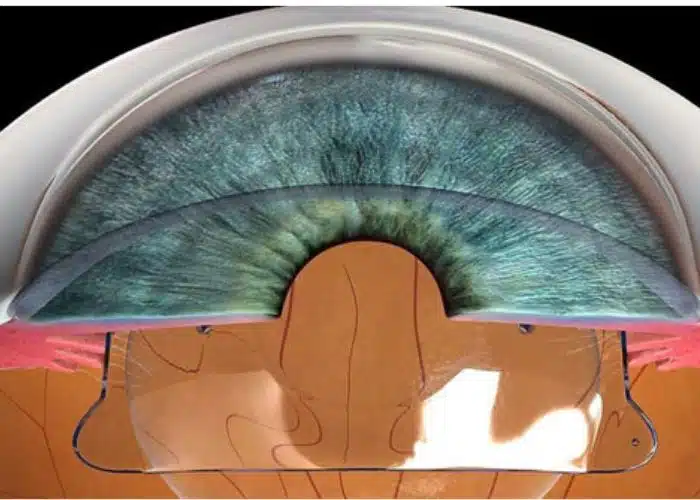Phakic ICL – A Safe Choice for Patients with Severe Congenital Myopia
Severe Congenital Myopia and Treatment Challenges

Children with severe congenital myopia often have to wear thick glasses from an early age
Severe congenital myopia (usually from −6.00D or higher) is a condition in which a child is born with a high degree of nearsightedness due to abnormal eye structure. Patients often depend on thick glasses from a young age, limiting their ability to study, work, and increasing the risk of retinal complications. For those with thin corneas, dry eyes, or very high refractive errors, laser methods are often not suitable, creating the need for a safe solution with minimal corneal intervention.
What is Phakic ICL?
Phakic ICL is an ultra-thin biological lens (~0.001 mm) made of Collamer Hydrophilic (natural collagen + transparent polymer). It is implanted through a very small incision (2.2–2.8 mm) and fixed behind the iris and in front of the natural lens. Each lens is customized based on the patient’s eye parameters to ensure the best visual quality.
- Refractive range: Myopia −3.0D to −20.0D; Astigmatism 1.0D to 4.0D.
- Recommended age: 21–45 years, stable prescription ≥ 1 year.
- Biocompatibility: soft, comfortable, no foreign body sensation, harmonious with natural eyes.
- UV protection: Collamer material helps filter harmful UV rays.
Key Benefits for Patients with Severe Congenital Myopia
- Phakic ICL provides sharp, stable vision, improving almost immediately after surgery with natural visual quality.
- It does not cause dry eyes since it does not affect the corneal surface, and it helps maintain excellent night vision.
- The procedure is quick, only about 20–30 minutes, with most patients resuming normal activities after 1–2 days.
- Phakic ICL also offers long-term flexibility, as the lens can be removed in the future if medically required.
Procedure Process

Simulation of Phakic ICL lens placement inside the eye
- Pre-operative assessment: measuring refraction, anterior chamber depth, endothelial cells, and selecting the appropriate lens size.
- Surgery day: topical anesthesia, creating a 2.2–2.8 mm micro-incision, and placing the Phakic ICL in position.
- Post-operative care: prescribed eye drops and regular follow-ups to ensure stability and visual quality.
Global Achievements
Phakic ICL was approved by the U.S. FDA in 2005, confirming its safety and clinical effectiveness in treating moderate to high myopia. To date, this technology has been adopted in over 75 countries with millions of successful implantations, making it a popular choice in leading eye centers worldwide. Clinical studies have shown very high patient satisfaction rates, with stable and long-lasting vision outcomes.
Phakic ICL Cost in Vietnam
The reference cost ranges from 80 – 115 million VND for both eyes, depending on the center, service package, and eye condition. At TD Eye, patients are offered 0% interest installment plans, long-term warranty from STAAR Surgical, along with special discounts for students, families, and free post-operative care for 12 months.
| Category | Details |
|---|---|
| Surgery cost | 80 – 115 million VND/2 eyes (depending on package, surgeon’s expertise, and equipment). |
| Basic benefits | Pre-op consultation and measurements; surgery; prescribed eye drops; scheduled follow-ups. |
| Financial support | 0% installment plan (if applicable); discounts depending on the clinic’s program. |
| Post-op care | Guidance on eye care; long-term monitoring of lens stability; optimized vision quality. |
*Costs are indicative; please contact the clinic for a detailed quotation based on individual conditions.
Who Should Consider Phakic ICL?

Phakic ICL lens placed on fingertip
- Patients with severe congenital myopia (−6.00D or higher) or high refractive errors within Phakic ICL’s treatment range.
- Patients with thin corneas, dry eyes, or corneal shapes unsuitable for surface procedures.
- Patients with stable refraction ≥ 1 year; meeting all safety criteria (anterior chamber depth, endothelial cells) as assessed by the doctor.
Safety Notes & Follow-up
- Monitor intraocular pressure, corneal endothelial cells, and vault regularly after surgery.
- Rare risks include increased intraocular pressure, cataract formation over time, or endothelial cell changes.
- Strict adherence to medication and follow-up visits ensures optimal results and long-term safety.
In summary, for patients with severe congenital myopia, Phakic ICL offers the optimal treatment choice thanks to its safety, quick recovery, and superior visual outcomes. With millions of successful surgeries worldwide and near-perfect satisfaction rates, Phakic ICL has affirmed its position as a sustainable, modern solution for the future of vision.

 vi
vi 25-Aug-2025
25-Aug-2025










 0916.741.763
0916.741.763 Appointment
Appointment